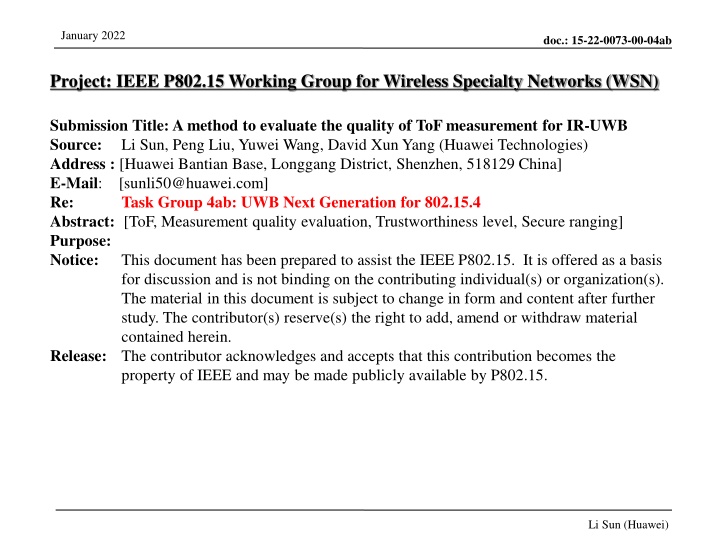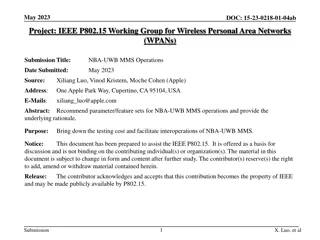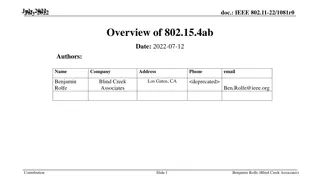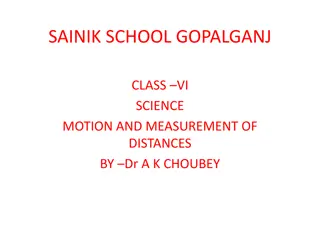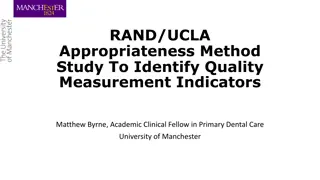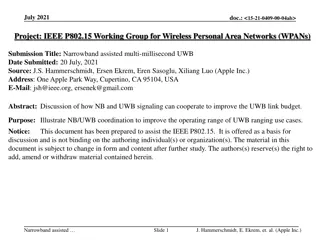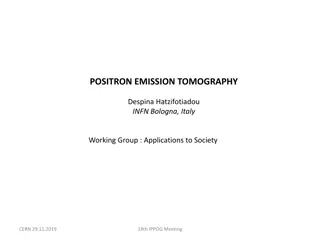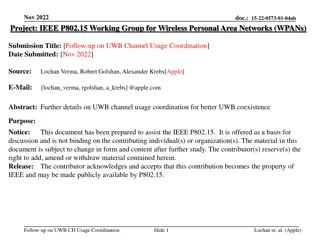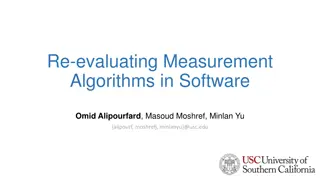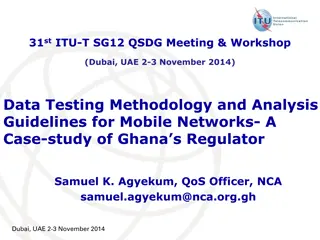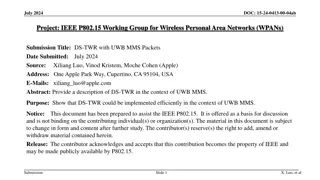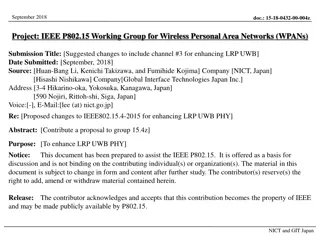Evaluating ToF Measurement Quality in IR-UWB Networks
This submission presents a method to assess the quality of Time-of-Flight (ToF) measurements in Impulse Radio Ultra-Wideband (IR-UWB) networks. The authors, affiliated with Huawei Technologies, propose a novel approach that enhances the accuracy and reliability of ToF measurements, crucial for wireless specialty networks.
Download Presentation

Please find below an Image/Link to download the presentation.
The content on the website is provided AS IS for your information and personal use only. It may not be sold, licensed, or shared on other websites without obtaining consent from the author.If you encounter any issues during the download, it is possible that the publisher has removed the file from their server.
You are allowed to download the files provided on this website for personal or commercial use, subject to the condition that they are used lawfully. All files are the property of their respective owners.
The content on the website is provided AS IS for your information and personal use only. It may not be sold, licensed, or shared on other websites without obtaining consent from the author.
E N D
Presentation Transcript
January 2022 doc.: 15-22-0073-00-04ab Project: IEEE P802.15 Working Group for Wireless Specialty Networks (WSN) Submission Title: A method to evaluate the quality of ToF measurement for IR-UWB Source: Li Sun, Peng Liu, Yuwei Wang, David Xun Yang (Huawei Technologies) Address : [Huawei Bantian Base, Longgang District, Shenzhen, 518129 China] E-Mail: [sunli50@huawei.com] Re: Task Group 4ab: UWB Next Generation for 802.15.4 Abstract: [ToF, Measurement quality evaluation, Trustworthiness level, Secure ranging] Purpose: Notice: This document has been prepared to assist the IEEE P802.15. It is offered as a basis for discussion and is not binding on the contributing individual(s) or organization(s). The material in this document is subject to change in form and content after further study. The contributor(s) reserve(s) the right to add, amend or withdraw material contained herein. Release: The contributor acknowledges and accepts that this contribution becomes the property of IEEE and may be made publicly available by P802.15. Li Sun (Huawei)
January 2022 doc.: 15-22-0073-00-04ab PAR Objective Safeguards so that the high throughput data use cases will not cause significant disruption to low duty-cycle ranging use cases Interference mitigation techniques to support higher density and higher traffic use cases Other coexistence improvement Backward compatibility with enhanced ranging capable devices (ERDEVs) Improved link budget and/or reduced air-time Additional channels and operating frequencies Improvements to accuracy / precision / reliability and interoperability for high-integrity ranging Proposed Solution (how addressed) This proposal presents a new metric to evaluate the trustworthiness level of ToF measurements, which can be used to combine multiple measurements in a better way and obtain a more reliable ranging result. Reduced complexity and power consumption Hybrid operation with narrowband signaling to assist UWB Enhanced native discovery and connection setup mechanisms Sensing capabilities to support presence detection and environment mapping Low-power low-latency streaming Higher data-rate streaming allowing at least 50 Mbit/s of throughput Support for peer-to-peer, peer-to-multi-peer, and station-to-infrastructure protocols Infrastructure synchronization mechanisms Li Sun (Huawei) Slide 2
January 2022 doc.: 15-22-0073-00-04ab Background and Motivations Ranging is usually done in complicated wireless environments, and the ranging accuracy is heavily affected by multipath, noise, interference, etc. measurements might be inaccurate Besides that, ranging is also vulnerable to several forms of distance reduction attacks such as Cicada[1], Cicada++[2], Ghost peak[3], etc. measurements might be untrustworthy It is necessary to give a quantitative evaluation on both the accuracy and trustworthiness of the ranging measurement results. Li Sun (Huawei) Slide 3
January 2022 doc.: 15-22-0073-00-04ab Current Standard: FoM FoM with extension bit=0 (Source: IEEE 802.15.4z-2020 [4])0 If extension bit = 0, the Figure-of-Merit (FoM) characterizes the accuracy of the PHY estimate of the arrival time of the RMARKER at the antenna. While FoM gives an evaluation of the ranging accuracy, there is no metric in current standard to provide an explicit indication of whether or not the ranging procedure is being attacked. FoM with extension bit 0 has a clear meaning, but FoM with extension bit 1 is not defined (unless bits 0~6 are all zeroes, which means the ranging result is incorrect). Li Sun (Huawei) Slide 4
January 2022 doc.: 15-22-0073-00-04ab Proposal 1: Extend the Definition of FoM Do integrity check to produce an integrity score z satisfying x z x, where x is the length of the STS (correlation-based integrity check method is assumed here as an example, but we do not exclude other methods) Example 15-22-0072-00-04ab: Integrity protection to support secure ranging in IR-UWB Slide 5 Li Sun (Huawei)
January 2022 doc.: 15-22-0073-00-04ab Proposal 1: Extend the Definition of FoM Modified definition of FoM z=x: this corresponds to the case where the receiver is sure that no attack exists. In this case, bit 7 is set to be 0, and other bits are defined as is done in current standard to reflect ranging accuracy ? ? ?: this corresponds to the case where the receiver is sure that an attack occurs. In this case, set bit 7=1 and all other bits to be 0 the measurement result cannot be used (compatible with current standard) ? ? ? ?: the ranging procedure is being attacked with a possibility that is inversely proportional to z. Set bit 7=1, and other bits are the binary representation of the trustworthiness level, defined as ? 2 27 2 ? 1 + 1 where = (z 1 ??? ? > 2) round Slide 6 Li Sun (Huawei)
January 2022 doc.: 15-22-0073-00-04ab Proposal 1: Extend the Definition of FoM Main points for the modified definition of FoM : Bits 0~6 Bit 7 Bit 7=0: there is no attack, and bits 0~6 characterizes the accuracy of the ToF estimate, as is defined in current standard Bit 7=1: there might be an attack, and bits 0~6 characterizes the trustworthiness level of the ToF estimate (i.e., the possibility of not being attacked), defined as ? 1 Trustworthiness level= round + 1 , ????????? ????? ? 1 0, ????????? ????? ? 0 You cannot characterize both accuracy and trustworthiness using one FoM unless bit 7=0 introduce a new metric Slide 7 Li Sun (Huawei)
January 2022 doc.: 15-22-0073-00-04ab Proposal 2: A new metric Trustworthiness Level (TL) Bits 0~6 Bit 7 Trustworthiness characterization usefulness indicator Do integrity check to produce an integrity score z satisfying x z x, where x is the length of the STS TL definition: bit 7=0 if x z 0 (the receiver is sure that the ranging procedure is being attacked and the measurement is thus useless) and bit 7=1 if 1 z x (there might be an attack, but the receiver is not pretty sure, so the measurement can still be used) If bit 7=0, bits 0~6 are all equal to 0 to indicate the measurement is useless If bit 7=1, bits 0~6 are the binary representation of the trustworthiness level, defined as round ? 1 27 1 ? 1 where = (z 1 ??? ? > 1) Slide 8 Li Sun (Huawei)
January 2022 doc.: 15-22-0073-00-04ab The feedback of TL Whether or not the feedback of TL is necessary depends on where the TL is computed and what it is used for. In this example, TL is computed at the initiator and is used to measure the trustworthiness of the entire ranging round: No need to feedback Li Sun (Huawei) Slide 9
January 2022 doc.: 15-22-0073-00-04ab The feedback of TL Whether or not the feedback of TL is necessary depends on where the TL is computed and what it is used for. In this example, TL is computed at the responder and is used to measure the trustworthiness of a single ToA measurement: Feedback is needed Li Sun (Huawei) Slide 10
January 2022 doc.: 15-22-0073-00-04ab The feedback of TL from responder to initiator With the TLs available, the initiator can perform a weighted average (soft combining) of several measurements of a timestamp (e.g., t2) to get a more reliable result, where the weights are the TLs associated with these measurements (TLs should be normalized to be within the interval [0,1] such that they can be used as weights). The number of ranging rounds can be adjusted flexibly according to the collected TL reports. For example, more ranging rounds are needed if there are too many poor TL reports, implying the higher possibility of being attacked. The TL reports can be included in the RangingReportDescriptor as a new element, and fed back from the responder to the initiator. Initiator Responder Ranging t1 t2 t3 Ranging t4 timestamp repots & the associated TLs Li Sun (Huawei) Slide 11
January 2022 doc.: 15-22-0073-00-04ab Summary The quality of ToF measurements needs to be evaluated in a more comprehensive way, which can reflect not only the accuracy but also the trustworthiness of the measurements We propose two methods to address the aforementioned issue, i.e., to extend the current definition of FoM or to introduce a new metric called trustworthiness level (TL) When necessary, TL reports should be fed back from the responder to the initiator to obtain a more reliable ranging result and enable a more flexible ranging procedure Li Sun (Huawei) Slide 12
January 2022 doc.: 15-22-0073-00-04ab References [1] M. Poturalski, M. Flury, P. Papadimitratos, J.-P. Hubaux, J.-Y. Le Boudec, The Cicada attack: Degradation and denial of service in IR ranging, in Proceedings of the IEEE ICUWB 2010. [2] M. Singh, M. Roschlin, E. Zalzala, P. Leu, S. Capkun, Security analysis of IEEE 802.15.4z/HRP UWB time-of-flight distance measurement, in Proceedings of the 14th ACM Conference on Security and Privacy in Wireless and Mobile Networks, June 2021. [3] P. Leu, G. Gamurati, A. Heinrich, M. Rosechlin, C. Anliker, M. Hollick, S. Capkun, J. Classen, Ghost peak: Practical distance reduction attacks against HRP UWB ranging, https://arxiv.org/abs/2111.05313, Nov. 2021. [4] 802.15.4z-2020 - IEEE Standard for Low-Rate Wireless Networks-- Amendment 1: Enhanced Ultra Wideband (UWB) Physical Layers (PHYs) and Associated Ranging Techniques. Li Sun (Huawei) Slide 13
